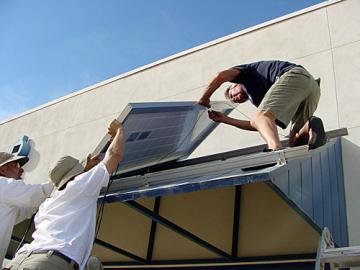Arizona renewable energy poised to grow

 More than 80 applications have been filed in Arizona for wind and power plants. If even some of them are approved, it would mean thousands of new jobs, increased tax revenues, and other economic benefits, as well as being a major step towards the state-mandated goal of 15% renewable energy by 2025.
More than 80 applications have been filed in Arizona for wind and power plants. If even some of them are approved, it would mean thousands of new jobs, increased tax revenues, and other economic benefits, as well as being a major step towards the state-mandated goal of 15% renewable energy by 2025.
As of 2010, Arizona generated a tiny 0.3% of its energy from renewables so it clearly has a long ways to go. A number of hurdles stand in the way of renewable energy in Arizona.
Power grid: Transmission lines do not yet exist to handle the amount of power coming from these proposed new sites. They will need to be built. Who will pay for it and who will own them? These key questions are as yet unanswered. Further, the grid will need to be modernized. Wind and solar power, by their very nature, are variable. The grid will need to be able to handle hugely varying amounts of power. Energy generation can drop to zero in seconds when clouds pass over or the wind stops blowing, then ramp up again just as suddenly. The current grid wasn't designed for this. It assumes steady amounts of power from the large power plants. But that's not what happens with renewable energy.
Distributed energy, putting small wind and solar everywhere, especially in cities would bring the power closer to the users. But again, the grid wasn't built to handle huge amounts of fluctuating energy coming from all directions.
Stored energy is a solution. Wind and solar plants could store excess energy to be used later. But this technology isn't at grid scale yet. Pumped hydro is already in use (water is pumped uphill into a storage tank using excess energy then released when needed to power turbines.) Other methods include massive batteries and pumping compressed air into underground caverns. But these technologies and approaches do not yet exist at the massive scale needed.
NIMBYs: Big wind and solar projects will undoubtedly be delayed by NIMBYs (not in my backyard) blocking or slowing projects from being constructed. While there certainly are legitimate concerns here, the overall effect will be to slow development down, maybe for years. This can lead to projects being abandoned.
Among the concerns is water usage. Big solar can use large amounts of water. Concentrated Solar Power is particularly thirsty. CSP reflects the sun to a central tower where it heats water or other fluids which is then used to power turbines. It is cheaper to build CSP using water continuously refreshed from wells. Obviously, this is problematic in deserts. CSP can also recycle water but this is more expensive to build.
Financing: In order to get financing for these huge projects, the developer needs a buyer for the power. But renewable energy is more expensive than traditional energy. This may make some reluctant to buy the power or invest in the development.
If all the projects were to be approved, Arizona would create more energy than it uses and be able to export to other states, a happy set of circumstances indeed. While this probably won't happen in the near-term, imagine the benefits to Arizonians if it does happen.
In Arizona, coal is the largest producer of energy, while 2010 statistics show renewable-energy systems produced a paltry .3 percent. But as stated earlier, by 2025, state mandates dictate 15 percent of power produced in Arizona must be from renewable sources.



